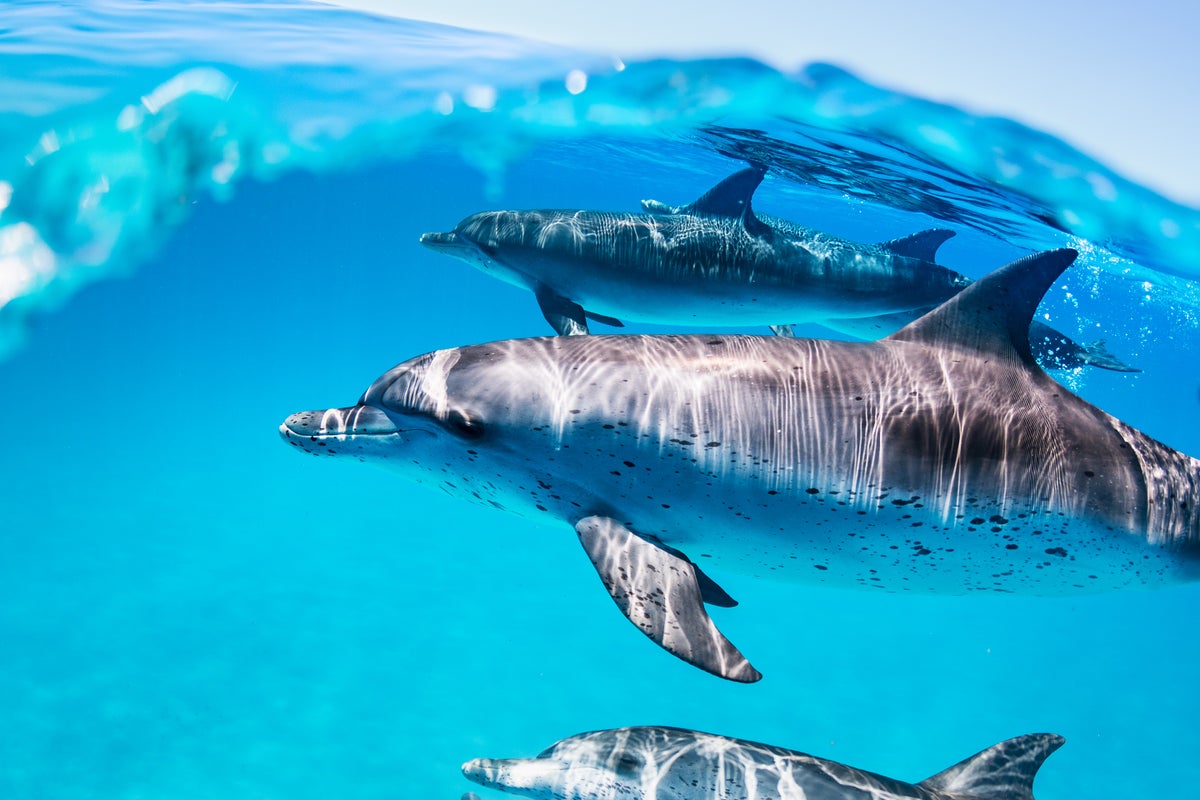Google Is Training AI to Speak Dolphin
Google is developing an LLM that could help us communicate with dolphins
A pod of Atlantic spotted dolphins (Stenella frontalis) swims below the ocean surface in Bimini, Bahamas.
Dolphins are renowned for their intelligence and social skills. These large-brained marine mammals communicate using individualized signature clicks and whistles and even seem to recognize their own “names.” Big advances in artificial intelligence have renewed some scientists’ dream of eventually understanding what dolphins are saying. But what if we humans could also respond?
WDP, whose scientists have studied Atlantic spotted dolphins (Stenella frontalis) for 40 years, provided acoustic data from the species to train the LLM. Teams at Georgia Tech and Google then asked the model to generate “dolphinlike” sequences of sounds. “Half of it was background noise stuff that you expect from the ocean,” says computer scientist Thad Starner, of Georgia Tech and Google DeepMind. But the rest had authentic-sounding clicks, whistles and burst pulses—rapid sequences of clicks that dolphins often utter during fighting and other close-proximity behavior.
If you’re enjoying this article, consider supporting our award-winning journalism by subscribing. By purchasing a subscription you are helping to ensure the future of impactful stories about the discoveries and ideas shaping our world today.
“When I first heard it played back…, I was dancing around the room,” Starner says. He hadn’t yet been able to reproduce burst pulses using his conventional computer programs. Generating sound programmatically requires a human to write code, but LLMs create instructions for making new sounds independently, based on what they’ve learned from data.
The team now wants to project how AI completes vocalization sequences—like “when I’m typing into Google and it’s finishing my sentence,” says WDP founder Denise Herzing. Manually, “it would take some 150 years to go through all the data and try to pull out those patterns.”
Using AI analysis isn’t just quicker. It “could give us the opportunity to see patterns that, from a human perspective, we may not look at,” says Thea Taylor, managing director ofSussex Dolphin Project, who is not involved in the new project.
If the LLM consistently returns the same answers, it might reveal a pattern. Reviewing WDP’s video data could then show researchers what the dolphins are doing when they make a specific sound: Are they, for example, playing with friends or fighting with a rival?
The team also wants to explore how dolphins react when researchers present them with novel vocalizations—dolphinlike “words” made up by AI—to refer to items such as seagrass or a toy.
This is an interesting approach, but researchers must take care that they aren’t unintentionally training the dolphins, Taylor says. If the dolphins repeat the sound, “we have to think whether that’s actually an understanding of language—or whether it’s the same as teaching a dog to sit because they get a reward.”
And it’s still unclear whether dolphins technically even have language. Arik Kershenbaum, a zoologist who studies animal communication at Girton College in England and isn’t involved in the project, thinks they do not. “Language is infinitely complex,” he says. “If you have a separate word for every object in your environment, that’s not a language.” There are limits, Kershenbaum says, to what dolphins can convey through their vocalizations.
Dolphin whistles have variations in them, and we don’t know if these mean different things. “It’s not immediately clear that dolphins have words,” he notes. This is a potential concern; for LLMs to conduct their analysis, they rely on a wordlike sequence of symbols. This “big question mark” over whether two similar—but not identical—symbols (whistles) mean the same thing could make it difficult for AI to interpret the sequence, he says.
It’s also worth remembering that this is just one population within one species, Taylor says. “Individual networks can have their own vocalization differences,” she adds.
Kershenbaum compares the project to the film Star Trek IV: The Voyage Home: when the crew of the starship Enterprise tries to communicate with humpback whales, they can simulate whale song but not its meaning. “This is not about translation,” he says.
So we aren’t going to have a what we usually call a “conversation” with dolphins anytime soon. If the animals do appear to recognise complex AI sequences as having meaning, however, “that still gives us a window into their cognitive abilities,” Kershenbaum says.
Other groups, such as the Earth Species Project and the Project CETI (Project Cetacean Translation Initiative), are pursuing similar projects to decipher the vocalizations of crows and sperm whales.
Humans often see language as the thing that sets us apart from animals. Herzing wonders if we’d have more empathy for dolphins if we could confirm that they use language. “Maybe [understanding them] would make us connect differently—and realize that these species have the right to a healthy existence,” she says.
Melissa Hobson, doing business as The Ocean Writer Ltd., is a marine science and conservation writer based in Hastings, U.K. She has written about the ocean for outlets including National Geographic, New Scientist, the Guardian and the Sunday Times. Visit Melissa’s website at https://www.melissahobson.co.uk/ or follow her on LinkedIn.
Source: www.scientificamerican.com
